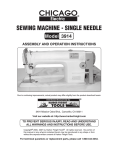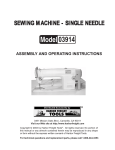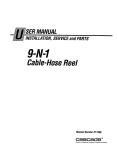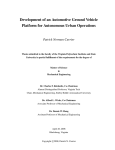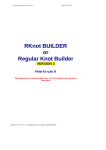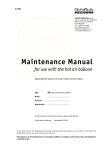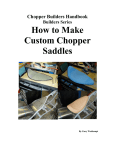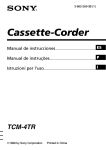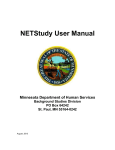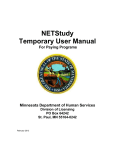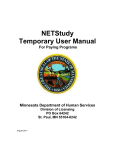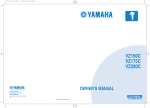Download Harbor Freight Tools 3914 User's Manual
Transcript
Single needle industrial sewing Machine Model 3914 Set up and Operating Instructions Visit our website at: http://www.harborfreight.com Read this material before using this product. Failure to do so can result in serious injury. Save this manual. Copyright© 2005 by Harbor Freight Tools®. All rights reserved. No portion of this manual or any artwork contained herein may be reproduced in any shape or form without the express written consent of Harbor Freight Tools. Diagrams within this manual may not be drawn proportionally. Due to continuing improvements, actual product may differ slightly from the product described herein. Tools required for assembly and service may not be included. For technical questions or replacement parts, please call 1-800-444-3353. REV 07f, 10b Specifications Machine Type Heavy duty, industrial sewing machine; high speed, single needle-lock stitch Drive V-belt driven (size 41 replacement belt) Action Foot pedal operation, along with a knee and manual lifting arm for presser foot. Feed Type Link style needle feed Sewing Directions Forward and reverse feed Machine Dimensions 20-3/4” L x 10” H Table Stand Kit - 2 Screwdrivers- 3 Bobbins- Small lubricating bottle with tip- Spare needles (size 90/14) - Power Switch Table Stand Kit (Model 03929) not included Stitching Speed 5,500 SPM (Strokes per minute) Motor Type Clutch motor; 3,450 RPM, 5.8/2.9 amps, 110/220 V~, 60 Hz; single phase Sewing Thickness up to 5/16” Overall weight 61.6 lb. Accessories Note: Performance of this tool may vary depending on variations in local line voltage. Extension cord usage may also affect tool performance. Warning: Make certain that the voltage switch on the motor is set correctly for your use. See page 6. This machine is set up for 110V usage. Rewiring of the plug and an approriate outlet is required for 220V usage. This Machine requires oil to be added before use - see page 6 for details. Read all instructions before using this tool! Save This Manual You will need the manual for the safety warnings and precautions, assembly instructions, operating and maintenance procedures, parts list and diagram. Keep your invoice with this manual. Write the invoice number on the inside of the front cover. Keep the manual and invoice in a safe and dry place for future reference. 1. Keep work area clean. Cluttered areas invite injuries. 2. Safety Warnings and Precautions Observe work area conditions. Do not use machines or power tools in damp or wet locations. Don’t expose to rain. Keep work area well lighted. Do not use electrically powered tools in the presence of flammable gases or liquids. 3. WARNING: When using tool, basic safety precautions should always be followed to reduce the risk of personal injury and damage to equipment. Keep children away. Children must never be allowed in the work area. Do not let them handle machines, tools, or extension cords. 4. Store idle equipment. When not in use, tools must be stored in a dry location to REV 03d, 03e, 04c, 10b Page 2 For technical questions, please call 1-800-444-3353. SKU 3914 inhibit rust. Always lock up tools and keep out of reach of children. 5. Use the right product for the job. Do not attempt to force a small product or attachment to do the work of a larger industrial tool. There are certain applications for which this product was designed. It will do the job better and more safely at the rate for which it was intended. Do not modify this product and do not use this product for a purpose for which it was not intended. 6. Dress properly. Do not wear loose clothing or jewelry as they can be caught in moving parts. Protective, electrically nonconductive clothes and nonskid footwear are recommended when working. Wear restrictive hair covering to contain long hair. 7. Do not overreach. Keep proper footing and balance at all times. Do not reach over or across running machines. 8. Maintain tools with care. Keep needles sharp and tools clean for better and safer performance. Follow instructions for lubricating and changing accessories. Inspect tool cords periodically and, if damaged, have them repaired by a qualified technician. The handles must be kept clean, dry, and free from oil and grease at all times. 9. Disconnect power. Always turn the machine off and, if possible, disconnect the power plug of the machine from the receptacle before adjusting, repairing, or cleaning the machine; leaving the machine unattended; tilting the machine head; or removing the V-belt. 10. Remove adjusting keys and wrenches. Check that keys and adjusting wrenches are removed from SKU 3914 the machine work surface before plugging it in. 11. Avoid unintentional starting. Be sure the switch is in the Off position when not in use and before plugging in. 12. Stay alert. Watch what you are doing, use common sense. Do not operate when you are tired. 13. Check for damaged parts. Before using any product, any part that appears damaged should be carefully checked to determine that it will operate properly and perform its intended function. Check for alignment and binding of moving parts; any broken parts or mounting fixtures; and any other condition that may affect proper operation. Any part that is damaged should be properly repaired or replaced by a qualified technician. Do not use if any switch does not turn On and Off properly. 14. Guard against electric shock. Prevent body contact with grounded surfaces such as pipes, radiators, ranges, and refrigerator enclosures. 15. Replacement parts and accessories. When servicing, use only identical replacement parts. Use of any other parts will void the warranty. Only use accessories intended for use with this tool. Approved accessories are available from Harbor Freight Tools. 16. Do not operate tool if under the influence of alcohol or drugs. Read warning labels if taking prescription medicine to determine if your judgment or reflexes are impaired while taking drugs. If there is any doubt, do not operate the tool. 17. Use proper size and type extension cord. If an extension cord is required, it must be of the proper size and type For technical questions, please call 1-800-444-3353. Page 3 to supply the correct current to the tool without heating up. Otherwise, the extension cord could melt and catch fire, or cause electrical damage to the tool. This tool requires use of an extension cord with up to 10 amps capability (up to 50 feet), with wire size rated at 18 AWG. Longer extension cords require larger size wire. If you are using the tool outdoors, use an extension cord rated for outdoor use (signified by “WA” on the jacket). 18. Maintenance. For your safety, service and maintenance should be performed regularly by a qualified technician. 19. People with pacemakers should consult their physician(s) before use. Electromagnetic fields in close proximity to heart pacemaker could cause pacemaker interference or pacemaker failure. 20. WARNING: The brass components of this product contain lead, a chemical known to the State of California to cause birth defects (or other reproductive harm). (California Health & Safety code § 25249.5, et seq.) 21. The warnings, cautions, and instructions discussed in this instruction manual cannot cover all possible conditions and situations that may occur. It must be understood by the operator that common sense and caution are factors which cannot be built into this product, but must be supplied by the operator. Sewing Safety Precautions 1. 2. Do not place your fingers into the thread take-up cover while the machine is operating. 3. Never leave the machine running and unattended. 4. During operation, never place your head, hair, or hands in the proximity of the hand wheel, V-belt, bobbin winder, or motor. 5. Do not operate the machine with any safety guards removed. 6. This machine shall only be operated by appropriately trained operators. 7. For your personal protection, we recommend you wear ANSI approved safety glasses when using the machine. 8. If oil or grease comes in contact with your eyes or skin, immediately wash the affected areas and consult a physician. 9. Tampering, modifying or altering any device (aside from the cord and plug by a licensed electrician) on the machine is prohibited and will void manufacturer’s warranty. 10. Repair, adjustment, and specific maintenance shall only be performed by a qualified service technician. Alteration or replacement of the 3 prong grounded electrical plug provided with the machine must only be performed by a licensed electrician. This machine must be properly grounded. 11. This sewing machine is only to be used for the purpose intended. Keep hands away from the needle when you turn the power switch on, or while the machine is operating. REV 07a, 10b Page 4 For technical questions, please call 1-800-444-3353. SKU 3914 Grounding To prevent electric shock and death from incorrect grounding wire connection: Check with a qualified electrician if you are in doubt as to whether the outlet is properly grounded. Do not modify the power cord plug provided with the tool. Never remove the grounding prong from the plug. Do not use the tool if the power cord or plug is damaged. If damaged, have it repaired by a service facility before use. If the plug will not fit the outlet, have a proper outlet installed by a qualified electrician. 2. The grounding prong in the plug is connected through the green wire inside the cord to the grounding system in the tool. The green wire in the cord must be the only wire connected to the tool’s grounding system and must never be attached to an electrically “live” terminal. (See 3-Prong Plug and Outlet.) 3. The tool must be plugged into an appropriate outlet, properly installed and grounded in accordance with all codes and ordinances. The plug and outlet should look like those in the preceding illustration. (See 3-Prong Plug and Outlet.) Grounded Tools: Tools with Three Prong Plugs Extension Cords 1. Grounded tools require a three wire extension cord. Double Insulated tools can use either a two or three wire extension cord. 2. As the distance from the supply outlet increases, you must use a heavier gauge extension cord. Using extension cords with inadequately sized wire causes a serious drop in voltage, resulting in loss of power and possible tool damage. (See Table A.) 3. The smaller the gauge number of the wire, the greater the capacity of the cord. For example, a 14 gauge cord can carry a higher current than a 16 gauge cord. (See Table A.) 4. When using more than one extension cord to make up the total length, make sure each cord contains at least the minimum wire size required. (See Table A.) 5. If you are using one extension cord for more than one tool, add the nameplate amperes and use the sum to determine 3-Prong Plug and Outlet 1. Tools marked with “Grounding Required” have a three wire cord and three prong grounding plug. The plug must be connected to a properly grounded outlet. If the tool should electrically malfunction or break down, grounding provides a low resistance path to carry electricity away from the user, reducing the risk of electric shock. (See 3-Prong Plug and Outlet.) REV 10b SKU 3914 For technical questions, please call 1-800-444-3353. Page 5 6. 7. 8. the required minimum cord size. (See Table A.) Symbology If you are using an extension cord outdoors, make sure it is marked with the suffix “W-A” (“W” in Canada) to indicate it is acceptable for outdoor use. Double Insulated Make sure the extension cord is properly wired and in good electrical condition. Always replace a damaged extension cord or have it repaired by a qualified electrician before using it. Protect the extension cords from sharp objects, excessive heat, and damp or wet areas. RECOMMENDED MINIMUM WIRE GAUGE FOR EXTENSION CORDS* (120/240 VOLT) EXTENSION CORD NAMEPLATE LENGTH AMPERES (at full load) 25’ 50’ 75’ 100’ 150’ 0 – 2.0 18 18 18 18 16 2.1 – 3.4 18 18 18 16 14 3.5 – 5.0 18 18 16 14 12 5.1 – 7.0 18 16 14 12 12 7.1 – 12.0 18 14 12 10 - 12.1 – 16.0 14 12 10 - - 16.1 – 20.0 12 10 - - - TABLE A * Based on limiting the line voltage drop to five volts at 150% of the rated amperes. Canadian Standards Association Underwriters Laboratories, Inc. V~ A Volts Alternating Current Amperes No Load Revolutions per Minute n0 xxxx/min. (RPM) Unpacking When unpacking, check to make sure that the parts shown in the photo on the following page are included. Note that the machine table shown is not included, and must be ordered separately. If any parts are missing or broken, please call Harbor Freight Tools at the number on the cover of this manual as soon as possible. REV 10b Page 6 For technical questions, please call 1-800-444-3353. SKU 3914 of the machine, depending on the user’s preference. Assembly Sewing Machine Hinge Indentations in Tabletop Table Stand and Top (not provided) Back of Sewing Machine Power Switch Motor Knee Lifting Arm for Presser Foot Oil Pan (1g) Figure 1 The assembly instructions describe mounting the Single-Needle Sewing Machine (Model 03914) to the Table Stand (Model 03929), not included. In order to complete this procedure, you must first purchase and assemble the Table Stand Kit (Model 03929). Installing the Oil Pan and Sewing Machine to the Tabletop of Industrial Sewing Machine Table (SKU 3929 - sold separately) Hinge (1h) Figure 3 2. Seat the Oil Pan (1g) on the Rubber Pads and Cushions in the Tabletop opening. 3. Insert the Hinge Cushions (2h) into the tabletop, securing them with two Tacks (25g) in each Hinge Cushion. 4. Insert the Hinges (1h) into the holes in the back of the Sewing Machine. Oil Pan (1g) hole in Tabletop (30) Rubber Pads (23g) Corner Rests Rubber Cushions (24g) Machine Rest Pin (19h) (Operator Side of Table) Rubber Pads (23g) Rubber Cushions (24g) Figure 2 1. Working in the rectangular hole of the Tabletop where the Oil Pan (1g) will sit: Place the Rubber Cushions (24g) on the operator-side corner rests, and the Rubber Pads (23g) on the hinge-side corner rests. Secure with two Tacks (25g) in each Pad or Cushion. Figure 4 5. Insert the Machine Rest Pin (19h) in the hole provided in the table stand. 6. Carefully place the machine, hinge side first, into the Rubber Hinge Plates and over the Oil Pan. Note: The Rubber Pads (23g) are optional. They may be omitted, or used under the Rubber Cushions (24g) to adjust the tilt REV 07f, 10b SKU 3914 For technical questions, please call 1-800-444-3353. Page 7 Knee Press Lifter Rod (2g) Oil Pan Magnet (22g) Oil Sight Window (1f) Mounting the Motor Note: The Motor is heavy. You will need a helper to hold the motor in place while tightening the Nuts (67j) on the Carriage Bolts (70j) in step 5 on the following page. Motor Rotation Switch Always keep to right Hand Wheel (7b) Figure 5 7. Tilt the machine back to expose the Oil Pan (1g). Insert the Knee Press Lifter Rod (2g). Place the Oil Pan Magnet (22g) in the lowest portion of the Oil Pan. 8. Fill the Oil Pan with the Oil (20h) to the “High” mark “A”. Add more oil when the level is to the “Low” mark “B”. After lubrication, and during operation, oil splashing can be seen through the Oil Sight Window (1f). 9. Tilt the machine head back to the table top. 110/220 V Switch Always keep to left (110V) (Unless power plug is rewired for 220v by a qualified electrician.) Receptacle for 6 volt work light (not included) Figure 6 1. The motor can be set for 110V or 220v. Make certain that the voltage switch on the motor is set correctly for your use. This machine is set up for 110V usage. Set the 110/220V Switch to 110V (Switch to the left) unless you have your outlet changed to 220V by a qualified electrician. Rewiring of the plug and an approriate outlet is required for 220V usage. 2. The rotation of the motor can also be set to clockwise or counterclockwise rotation. This setting should always be set to the right, which makes the sewing machine pulley rotate counterclockwise. Do not use this setting to reverse the direction of the machine. Use the Reverse Control Lever (22e) to reverse the stitch feed direction when sewing. REV 03d, 03e, 07g, 10b Page 8 For technical questions, please call 1-800-444-3353. SKU 3914 Hand Wheel (7b) Sewing Machine Carriage Bolts (70j), Flat Washer (69j), Spring Washer (68j), Nut (67j) Belt (71j) Set Screws (8b) (One on each side of the Pulley) Main Shaft (32b) Figure 7 3. Figure 9 5. Slot in Tabletop for belt Bobbin Winder Assembly Slide the Sewing Machine Hand Wheel (7b) onto the Main Shaft (32b) of the Sewing Machine. Align one of the Set Screw holes (on the side of the Pulley) with the flat section of the Main Shaft. Tighten the Set Screws (8b) enough to hold the Pulley in place, but not fully tightened. Mount the Motor to the underside of the tabletop using the Carriage Bolts (70j), Flat Washers (69j), Spring Washers (68j), and Nuts (67j). Finger tighten only. Aligning the Pulleys Belt (71j) Motor Set Screw (7j) Back of Sewing Machine Slot with Pulley Belt Carriage Bolts (70j) flush with Tabletop Pulley (8j) Figure 10 Figure 8 4. Back of Tabletop Using a rubber mallet (sold separately) tap the three Carriage Bolts (70j) into the top of the Tabletop so that they are flush with the tabletop. REV 04c; 07g, 10b SKU 3914 1. Place the Belt (71j) around the Sewing Machine Hand Wheel (7b), through the slot in the table top, and around the motor Pulley (8j). Make sure the motor pulley is in line with the Sewing Machine Hand Wheel. If you cannot get the Pulleys to line up by sliding them slightly in either direction, you may need to turn the Motor Pulley around. To do this, loosen the Set Screw (7j) on the motor Pulley, slide the Pulley off of the motor For technical questions, please call 1-800-444-3353. Page 9 and turn it around. Move the belt by hand to verify that it is aligned and tracking correctly. Caution: Do not tighten the Belt so much that the left side of the Sewing Machine begins to lift up from the Oil Pan. 2. Once you have the Pulleys aligned, remove the Belt from the Sewing Machine Hand Wheel (7b), and tighten its Set Screws (8b). Replace the Pulley and tighten the Motor Set Screw (7j). 2. Once the Belt is the proper tension, tighten both Nuts against the Motor Housing Flange to hold the motor in place. 3. Attach the Pulley Safety Cover (1j) over the motor Pulley (8j), using the Bolt (2j), Spring Washer (3j), Flat Washer (4j), and Lock Nut (5j). 3. Install the Pulley Safety Cover (1j) over the motor Pulley (8j), using the Bolts (2j), Flat Washers (4j), Spring Washers (3j), and Nuts (5j). Back of Tabletop Machine Rest Pin (19h) hole Adjusting the Belt Tension Sewing Machine Opening Pulley Belt Slot Front of Tabletop Motor Housing Flange Possible ON/OFF Control Box locations ON/OFF Control Box shown mounted on right from underside of tabletop. Lower Nut (45j) Belt Adjustment Bolt (48j) Belt (71j) Figure 12 4. Mount the ON/OFF Control Box (63j) under the Tabletop, in one of the locations shown above, using the Wood Screws (72j) and Flat Washers (73j). 5. Connect the Treadle Joint Assembly (from the Tabletop To adjust length: 3929 - sold loosen nut Clutch separately) to the here, Arm slide end of the motor (19j) bars Clutch Arm (19j), as Treadle Joint using the nut and needed, Assembly then bolt on the end of and Treadle the Joint Assembly. tighten Pedal nut. (Tabletop Adjust the length #3929 - sold and/or location of separately) the components if needed. Figure 13 REV 04c, 05d, 07g, 10b Figure 11 1. To tighten the Belt (71j) tension, turn the lower Nut (45j) on the Belt Adjustment Bolt (48j) counterclockwise, moving the nut down towards the end of the bolt enough so that the motor hangs as low as its weight allows. Turn the upper Nut (45j) counterclockwise until it tightens against the Motor Housing Flange. The proper tension is reached when the Belt can only be pushed in 1/2 inch. Test the Belt tension. If it needs to be tighter, move the lower Nut and push the motor down. Tighten in place with the upper Nut. Page 10 Legs Legs Drawer Pre-drilled Engine mounting holes Upper Nut (45j) Motor Thread Stand hole For technical questions, please call 1-800-444-3353. SKU 3914 Mounting the Thread Stand Thread Hanger (28i) 7. Upper Spool Rest Rod (30i) Column Pipe Connector (33i) Lower Spool Rest Rod (36i) Spool Pins (40i) Note: The Support has tabs that hold onto the corners of the Nut to make tightening easier. When assembling, place the Nut on the side with these tabs. Figure 13 Note: The Thread Stand is designed to be mounted on the Table Stand Kit (Model 03929-sold separately). Unless indicated otherwise, all parts referred to in this set of instructions are listed in the I - Bobbin Winder & Thread Stand Unit Parts List and Diagram. During assembly, it will be helpful to refer to that list and diagram. Back of Tabletop Thread Stand hole Machine Rest Pin (19h) hole Legs Pre-drilled Engine mounting holes Sewing Machine Opening Pulley Belt Slot Front of Tabletop Possible ON/OFF Control Box location Figure 14 6. If needed, bend the Spool Support (46i) so it slides easily over the Lower Spool Rest Rod (36i), then slide it over the Lower Spool Rest Rod, about halfway down. Insert a Bolt (31i) and Nut (47i) through the Support. Place the Washer (37i) onto the Lower Spool Rest Rod (36i) and insert the Rod into the Thread Stand Hole in the far right back corner of the tabletop (see above). Place another Washer (37i) over the end of the Rod, and thread on and tighten a Nut (38i). 8. Tighten the Screw. 9. Insert the threaded end of the Spool Pin (40i) through one of the holes in the top of the arm of the Spool Support (46i). Place a Washer (32i) and Nut (35i) over the end of the Pin and tighten. Place the Spool Rest (41i), Spool Mat (42i), and the Spool Vibration Stopper (39i) over the end of the Spool Pin. Repeat this step for both of the Spool Pins (40i). 10. Place the Column Pipe Connector (33i) over the top of the Lower Spool Rest Rod (36i) until the Rod is about halfway through the Connector. Place a Bolt (34i) and Nut (35i) through the bottom hole in the Connector and finger-tighten. 11. Place the Upper Spool Rest Rod (30i) into the top of the Column Pipe Connector (33i). Place a Bolt (34i) and Nut (35i) through the top hole in the Connector. Tighten all of the Screws and Nuts in the Connector. 12. Remove the Column Cap (29i) from the top of the Upper Spool Rest Rod (30i). If needed, bend open the Thread Hanger (28i) so it slides easily over the Upper Spool Rest Rod. Slide the Thread Hanger about halfway over the top of the Upper Spool Rest Rod. Insert a Bolt (31i) and Nut (47i) through the Hanger as explained in the note in step 7, above. Tighten the Screw and place the Column REV 04c, 05d, 10b SKU 3914 For technical questions, please call 1-800-444-3353. Page 11 Cap over the end of the Upper Spool Rest Rod. Washers (27i). Leave the Screws just loose enough to allow the Base to slide. Less than 1/8” gap between Belt (71j) and Wheel (3i) Mounting the Bobbin Winder The Bobbin Winder is used to wind thread onto the Bobbin (17h). It is mounted so that it contacts the Belt (71j) when needed for bobbin winding. Belt (71j) Note: Unless indicated otherwise, all parts referred to in this set of instructions are listed in the I - Bobbin Winder & Thread Stand Unit Parts List and Diagram. During assembly, it will be helpful to refer to that list and diagram. 13. Set the Bobbin Winder to the ‘ON’ Position - See Bobbin Winder Operation on the following page. Wheel (3i) Figure 16 16. Put the Bobbin Winder in the ‘OFF’ position - See Bobbin Winder Operation on the following page. Slide the Bobbin Winder Assembly close to the belt until it just barely doesn’t touch it (1/8” gap or less) - as shown above. Tighten the Wood Screws (26i) securely. Installing the Belt Covers Mark Pilot Holes Here. Figure 15 14. Make sure the Bobbin Winder is in the ‘ON’ position. Position the Base (1i) so that the Wheel (3i) lines up with, and just touches, the belt. Mark pilot hole locations on the table through the center of each of the two channels in the Base, as indicated above. 15. Set the Base (1i) aside and drill pilot holes for each of the two marked locations. Reposition the base and secure using two Wood Screws (26i) and 1. Install the Front Belt Cover (4h) over the Sewing Machine Hand Wheel (7b), using the Belt Cover Support (11h), the Belt Cover Bolts (10h, 12h), and the Belt Cover Cap (5h). 2. To install the Rear Belt Cover (7h), align the cover on the Tabletop over the back side of the opening where the Belt (71j) enters the tabletop. Mark where to drill holes. Remove the Rear Belt Cover and drill pilot holes. Secure the Rear Belt Cover in place using Wood Screws (9h). Operation Caution: To properly break-in your new sewing machine, and avoid possible damage to the machine, sew at REV 07a, 10b Page 12 For technical questions, please call 1-800-444-3353. SKU 3914 moderate to slow speeds for the first 15 minutes of use. WARNING: Shut the machine off completely before working around the needle or other moving parts. BASIC SETTINGS You will need to make the following adjustments on a regular basis when using the machine. Attaching the Needle The needles supplied with the Sewing Machine are size 90/14 (DBX1). The shank is size 16 x 257. For leatherwork use a 16 x 95 needle. This machine can accommodate a needle up to size 22. Note: Industrial sewing machine needles have a round shank (the top part of the needle that slides up into the machine). Do not use needles, such as most home sewing needles, which have a flat area on the shank of the needle. 1. Unplug the Power Cord. 2. Select the proper needle size for the thread count and material being sewn. 3. Turn the Hand Wheel (7b) counterclockwise until the Needle Bar reaches the highest point of its stroke. right. Insert the Needle and push it up until it will go no farther. 5. While holding in place, securely tighten the Bolt. Bobbin Winder Operation The Bobbin Winder is used to wind thread onto the Bobbin. The Bobbin Winder has two positions, ‘ON’ and ‘OFF’: OFF Position Pull tab on Connecting Rod (6i) to disengage Winder Figure 18 OFF Position Pull the tab on the Connecting Rod (6i) to disengage the Winder from the Belt. The Bobbin Winder will not contact the belt. ON Position Press here to push Winder toward Belt Loosen Bolt (25c) Figure 19 Shank Figure 17 Front View 4. Side View Face indented section to right when inserting needle ON Position This position is with the Connecting Rod (6i) pressed, as shown above. The Shaft on the Bobbin Winder will spin, winding thread onto the Bobbin. Loosen the Bolt (25c) and hold Needle (23c) with its indented part facing to the REV 07a, 10b SKU 3914 For technical questions, please call 1-800-444-3353. Page 13 Winding Thread Onto the Bobbin Setting the Bobbin into the Bobbin Case and into the Machine Thread Guide Hole (43i) Bobbin (17h) Thread Tension Bracket (18i) Thread from Spool Tension (not Discs shown) (21i) Bobbin Case (21c) 1. Route the Thread from the Spool, up through the Thread Guide Hole (43i), through the hole in the Thread Tension Bracket (18i), then over and under between the Tension Discs (21i). 2. Wrap the thread end around the Bobbin (17h), overlapping it several times to secure the thread on the bobbin. 3. Place the Bobbin onto the Bobbin Winder Shaft (5i) Bobbin Connecting with the thread Winder Rod (6i) coming from Shaft underneath (See (5i) Figure 20). If needed, use the large Screw Driver (14h) or a pair of pliers Figure 21 (sold separately) to open or close the end of the Shaft so the Bobbin is snug enough to turn with the Shaft, yet can still be pulled off easily. 4. Turn on power to the Sewing Machine, press the Treadle Pedal, then the Connecting Rod (6i) to engage the Bobbin Winder and wind thread onto the Bobbin. When finished, release the Connecting Rod, the Treadle Pedal and turn off power to the Sewing Machine. Cut the thread and remove the Bobbin. Page 14 Bobbin (22c) B Figure 22 C 1. After filling the Bobbin (22c) with thread, hold it so that the thread exits to the left, and push it into the Bobbin Case (21c). 2. Following Figure 22, feed the thread through slit “A” and pull the thread in direction “C”. By doing so, the thread will pass under the tension spring and exit at notch “B”. 3. Verify that the Bobbin rotates in the direction of the arrow when thread “C” is pulled. 4. Pull out at least 4” of thread. 5. On the top of the machine, rotate the Hand Wheel counterclockwise until the needle is in its topmost position. Bobbin Winder Shaft (5i) Figure 20 A Underside of Machine Bobbin (22c) Thread Bobbin Case (21c) Hinged Latch on Bobbin Case Rotating Hook (20c) Figure 23 6. Holding the Bobbin Case by the hinged latch, insert the Bobbin Case into the Rotating Hook (20c) from the underside of the machine. 7. Release the hinged latch as the Bobbin Case slides into place. For technical questions, please call 1-800-444-3353. REV 07a, 10b SKU 3914 Threading the Top Thread Thread Hanger (28i) Set the spool of thread (sold separately) onto the top thread Spool Pin (40i), (the left Spool Pin), and thread it through the eyelet directly above on the Thread Hanger (28i). Guide the thread through the machine, following the steps and photos below. Note: There are two Spool Pins (40i). The left Pin is commonly used to hold the spool of thread for the top thread (the thread that passes through the top section of the machine), while the right Pin is used to hold the spool of thread that is used for winding the bobbin. Thread Tension Discs (27a) Thread Take-up Cover (17a) 2 4 3 2. Pass the thread up through the right eyelet then down through the left eyelet on the 3-Hole Thread Eyelet (31a). 3. Pass the thread between the two Thread Tension Discs (7a) pulling to the right until the thread catches in the Take-up Spring (9a). Then pass under the Thread Release Finger (31d) and behind the Thread Guide (35a). 4. Pass behind the Thread Take-up Cover (17a), through the Thread Take-up Eyelet (1b) from right to left, and down through the Faceplate Thread Guide (34a). 5. Pass the thread into the Wire Needle Bar Thread Guide (26c), through the hole in the Needle Bar Thread Guide (24c), through the Needle (23c) from left to right, under the wire guide and between the opening in the Presser Foot (9d). 6. To pull the bobbin thread up to the top of the machine, hold the top thread behind the Presser foot and turn the Hand Wheel (7b) counterclockwsie until the Needle catches the bobbin thread, Thread Guide (35a) 5 Thread Tension Discs (7a) Thread Release Finger ( 31d) Take-up Spring (9a) Wire Needle Bar Thread Guide (26c) Pass the thread between the two Thread Tension Discs (27a) on the top of the machine. 3-Hole Thread Eyelet (31a) 3 (detail) 5 (detail) Needle Bar Thread Guide (24c) Needle (23c) wire guide Presser Foot (9d) Figure 25 Figure 24 1. 1 Thread Take-up Eyelet (1b) Faceplate Thread Guide (34a) Spool Pins (40i) REV 10b SKU 3914 For technical questions, please call 1-800-444-3353. Page 15 pulling it to the top of the machine. Pull both threads behind the Presser Foot, leaving at least 4” of excess thread. Adjusting the Bobbin Thread Tension Adjusting the Stitch Length Increase Tension Stitch Length Dial (46e) Tension Adjustment Screw Decrease Tension Bobbin Case (21c) Figure 26 To increase or decrease the stitch length, turn the Stitch Length Dial (46e) to the desired number (in millimeters) as indicated at (A) above. Adjusting the Needle Thread Tension Tension Adjustment Knob (3a) Figure 27 1. Turn Tension Adjustment Knob (3a) clockwise to increase thread tension. 2. Turn Tension Adjustment Knob counterclockwise to decrease thread tension. Figure 28 1. Using a small flathead screwdriver (sold separately), turn the Tension Adjustment Screw on the Bobbin Case (21c) clockwise to increase bobbin tension. 2. Turn the Tension Adjustment Screw counterclockwise to decrease bobbin tension. Raising the Presser Foot The Presser Foot (9d) can be raised and lowered using the Presser Foot Lever (18d) or the Knee Lifter (21g). The Knee Lifter raises the Presser Foot momentarily (to a height of up to 1/2”), as long as it is pushed, while the Presser Foot stays in the raised or lowered position when using the Presser Foot Lever. REV 10b Page 16 For technical questions, please call 1-800-444-3353. SKU 3914 ADVANCED SETTINGS Raises Presser Foot The Sewing Machine is set at the factory for using with jean weight materials. The following adjustments are needed only when using the machine for unusual types of fabric or when changing machine components. These procedures should be performed only by a qualified sewing machine technician. Presser Foot Lever (18d) Lowers Presser Foot Adjusting the Feed Timing Figure 29 1. To raise the Presser Foot, turn the Presser Foot Lever up. The Presser Foot will go up about 1/4” and stop. 2. To lower the Presser Foot, turn the Presser Foot Lever down. Rotating Hook (20c) Set Screws Setting the Presser Foot Pressure Increase Tension Figure 30 Decrease Tension Figure 31 1. Presser Regulator (20d) Presser Spring Regulator Nut (19d) 1. Loosen the Presser Spring Regulator Nut (19d) by turning it counterclockwise. 2. Turn the Presser Regulator (20d) clockwise to increase Presser Foot pressure and counterclockwise to decrease Presser Foot pressure. 3. After adjustment, tighten the Presser Spring Regulator Nut. Loosen Set Screws on the side of the Rotating Hook (20c) and re-position the Rotating Hook as follows: a.To advance the feed timing in order to prevent uneven material feed, rotate the Rotating Hook up (clockwise). b.To delay the feed timing in order to increase stitch tightness, rotate the Rotating Hook down (counterclockwise). 2. Retighten the Set Screws. Adjusting Feed Dog Height The Feed Dog is factory adjusted so that it juts out from the Throat Plate surface .031” (0.8 mm) to .035” (0.9 mm). If the Feed Dog juts out too much, puckering may result when sewing lightweight materials. To adjust the height of the Feed Dog: REV 10b SKU 3914 For technical questions, please call 1-800-444-3353. Page 17 Feed Lifting Shaft Crank (1e) Bolt (2e) Feed Bar Body Subassembly (4e) 0.03”~0.033” ( ) 0.028”~0.031” ( ) 0.037”~0.041” ( 1. Loosen the Bolt (2e) of the Feed Lifting Shaft Crank (1e). 2. Move the Feed Bar Body Subassembly (4e) up or down to make the adjustment. 3. Tighten the Bolt (2e), being careful not to overtighten. Rubber Plug (46a) & Bolt (28c) Needle Bar Lower Bushing (27c) Needle Bar (31c) Hook Blade Point Needle Bar (31c) Figure 33 When using a DBX1 needle, align to marker line “A” on the Needle Bar (31c) with the bottom end of the Needle Bar Lower Bushing (27c), then tighten Bolt (28c). When using a DAX1 needle, align to marker line “B” on the Needle Bar (31c) with the bottom end of the Needle Bar Lower Bushing (27c), then tighten the Bolt (28c). 4. When using a DBX1 needle, loosen Rotating Hook (20c) Set Screws, turn the Hand Wheel, and align the marker line “B” on the Needle Bar (31c) with the bottom end of the Needle Bar Lower Bushing (27c). When using a DAX1 needle, align the marker line “D” on the Needle Bar (31c) with the bottom end of the Needle Bar Lower Bushing (27c). 5. After making the adjustments in steps 3 and 4, align the Hook Blade Point on the Rotating Hook (20c) with the center of the Needle. Provide a clearance of .001” to .004” (0.04 to 0.1 mm) between the Needle and the Hook Blade Point. This clearance is less than 1/64” (almost touching). Securely tighten the Set Screws on the Rotating Hook. If the clearance is too small, the tip of the Hook Blade Point will be abraded. If it is too large, it will lead to skipped stitches. ) Figure 32 Adjusting Needle-to-hook Timing 3. Rotating Hook (20c) 1. Turn the Hand Wheel (7b) to bring the Needle Bar down to the lowest point of its stroke. 2. Remove and set aside the Rubber Plug (46a). Loosen the Bolt (28c). REV 10b Page 18 For technical questions, please call 1-800-444-3353. SKU 3914 pulled out by the Thread Take-up Spring. Adjusting the Presser Bar Height c. The normal setting is when the marker on the Thread Guide is aligned with the center of the Bolt. Figure 34 Rubber Plug (37a) & Presser Bar Set Screw (32d) 1. Remove and set aside the Rubber Plug (37a), and loosen the Presser Bar Set Screw (32d). 2. Manually adjust the Presser Bar height, and the angle of the Presser Foot. 3. After adjusting, securely tighten the Set Screw and replace the Rubber Plug. Adjusting the Thread Take-up Stroke Thread Take-up Thread Guide (35a) Spring (9a) Thread Guide Bolt (36a) 2. Tighten the Thread Guide Bolt after adjusting the Thread Guide. Adjusting the Height of the Knee Lifter The standard height of the Presser Foot lifted using the Knee Lifter is 0.39 inch (10 mm). Stud (7g) Knee Press Lifter Crank (15g) Nut (8g) Figure 36 1. To adjust the Presser Foot lift up to 0.5 inch (13 mm), adjust the Nut (8g) placement on the Stud (7g), on the Knee Press Lifter Crank (15g). Needle Bar Thread Guide (24c) Normal Setting Presser Foot (9d) Figure 35 1. To adjust the thread take-up stroke, loosen the Thread Guide Bolt (36a) and slide the Thread Guide (35a) to the right or left as described following: a.When sewing heavy weight materials, move the Thread Guide (35a) to the left to increase the length of thread pulled out by the Thread Take-up Spring (9a). Figure 37 2. When the Presser Foot lift is adjusted over 0.39 inch (10 mm), be sure that the Needle Bar Thread Guide (24c) does not hit the Presser Foot (9d). This can be manually checked by turning the Hand Wheel (7b). b.When sewing lightweight materials, move the Thread Guide (35a) to the right to decrease the length of thread REV 10b SKU 3914 For technical questions, please call 1-800-444-3353. Page 19 Adjusting Sewing Speed with Pulleys (sold separately) This machine is a fast running machine. It can be adjusted to a slower running machine by changing the pulley on the motor to a smaller diameter pulley. Consult a qualified sewing machine repair shop to replace the pulley with a 1-3/4” or 1-1/2” pulley to slow the speed of the machine. Maintenance 1. Advanced Machine adjustments should only be performed by a qualified technician. 2. Check the oil level weekly when the machine is used daily. Add sewing machine oil as required to the high level marking. 3. Clean the machine with a clean, damp cloth. Do not use solvents or thinners. 4. After each use, check for lint build up and blow clean with pressurized air. Remove and discard any stray thread or fabric pieces. 5. Check the Belt (71j) tension after first use and then weekly, and adjust as described in Adjusting the Belt Tension under the assembly instructions. 6. When not in use, cover the machine and store in a clean and dry location. REV 10b Page 20 For technical questions, please call 1-800-444-3353. SKU 3914 MOTOR WIRING DIAGRAM REV 07g, 10b SKU 3914 For technical questions, please call 1-800-444-3353. Page 21 A - ARM BED PARTS LIST Part Description Qty 1a Arm Bed Assembly 1 2a Tension Complete Subassembly 1 3a Tension Adjustment Knob 1 4a Thread Disc Rotation Stopper 1 5a Thread Tension Spring 1 6a Thread Release Disc 1 7a Thread Tension Disc 2 8a Tension Screw 1 9a Take-up Spring 1 10a Thread Tension Post Socket 1 11a Set Screw 1 12a Tension Release Pin 1 13a Oil Packing Subassembly 1 14a Oil Packing Cover 1 15a Oil Wick 1 16a Screw 17a Part Description Qty 30a Rubber Plug Needle Draining Crank Hole 1 31a Three-hole Thread Eyelet 1 32a Faceplate 1 33a Faceplate Sealing Gasket 1 34a Faceplate Thread Guide 1 35a Thread Guide 1 36a Thread Guide Bolt 2 37a Rubber Plug 2 38a Bed Slide Subassembly 1 39a Slide Plate 1 40a Slide Plate Spring 1 41a Slide Plate Spring Screw 2 42a Throat Plate 1 43a Throat Plate Screw 2 1 44a Bed Screw Stud 4 Thread Take-up Cover 1 18a Take-up Lever Cover Screw 1 45a Rubber Plug Thread Take-up Lever Link Pin Hole 2 19a Faceplate Asm 1 46a Rubber Plug 1 20a Screw 8 47a Brand Plate 1 21a Gasket 1 48a Brand Plate Rivet 2 22a Rubber Plug 1 49a Main Shaft Bushing 1 23a Rubber Plug 1 50a Connecting Rod 1 24a Thread Tension Screw 1 51a Screw 2 25a Faceplate Thread Retaining Guide Subassembly 1 26a Faceplate Retaining Thread Guide 1 27a Thread Tension Disc 2 28a Thread Tension Spring 1 29a Thread Tension Screw 1 DOL Motor (Not Shown) 12-Ha Servo motor FESM(Slower replacement for stock motor, not 400a shown, optional) 1 Note: When ordering parts for this component use the suffix “a”. Note: Some parts are listed and shown for illustration purposes only, and are not available individually as replacement parts. REV 07a, 10b Page 22 For technical questions, please call 1-800-444-3353. SKU 3914 A- ARM BED ASSEMBLY DRAWING 46 Motor (DOL 12-Ha) (Not Shown) SKU 3914 For technical questions, please call 1-800-444-3353. Page 23 B - MAIN SHAFT PARTS LIST Part 1b 2b 3b 4b 5b 6b 7b 8b 9b 10b 11b 12b 13b 14b 15b 16b 17b Description Thread Take-up Eyelet Needle Bar Crank Set Screw Bolt O-Ring Thread Take-up Lever Link Hand Wheel Set Screw Sealing Ring Main Shaft Rear Bushing Sub-assembly Plate Feed Drive Cam Snap Ring Bolt Set Screw Main Shaft Thrust Collar Main Shaft Middle Bushing Qty Part 1 1 1 1 1 1 1 2 1 18b 19b 20b 21b 22b 1 1 1 1 2 2 1 1 23b 24b 25b 26b 27b 28b 29b 30b 31b 32b 33b 34b Description Qty Set Screw Thread Take-up Lever Link Pin Oil Wick End Bolt (left hand) Thread Take-up Crank Needle Bar Crank Connecting Rod Sub-assembly Needle Bearing Needle Bar Crank Wearing Plate Crank Oil Adjusting Sub-assembly Crank Oil Adjusting Sub-assembly Rubber Bushing O-Ring Main Shaft Felt Main Shaft Front Bushing Sub-assembly Main Shaft Bolt Bolt 1 1 1 1 1 1 1 1 1 1 1 1 1 1 1 2 1 Note: When ordering parts for this component use the suffix “b”. Note: Some parts are listed and shown for illustration purposes only, and are not available individually as replacement parts. REV 10b Page 24 For technical questions, please call 1-800-444-3353. SKU 3914 REV 10b B - MAIN SHAFT assembly DRAWING SKU 3914 For technical questions, please call 1-800-444-3353. Page 25 C- Stitch Drive PARTS LIST Part Description Qty Part Description Qty 1c Bolt 1 19c Rotating Hook Sub-assembly 1 2c Rotating Hook Positioning Finger 1 20c Rotating Hook 1 3c Upright Shaft Lower Bushing 1 21c Bobbin Case 1 4c Set Screw 8 22c Bobbin 1 5c Bevel Gear 1 23c Needle 1 6c Upright Shaft 1 24c Needle Bar Thread Guide 1 7c Bevel Pinion 1 25c Bolt 1 8c Bolt 2 26c Wire Needle Bar Thread Guide 1 9c Hook Driving Shaft Rear Bushing 1 27c Needle Bar Lower Bushing 1 10c Bolt 2 28c Bolt 1 11c Hook Driving Shaft Thrust Collar 1 29c Needle Bar Connecting Pin 1 12c Hook Driving Shaft 1 30c Needle Bar Guide Block 1 13c Hook Driving Shaft Front Bushing Sub-assembly 1 31c Needle Bar 1 14c Set Screw 1 32c Needle Bar Upper Bushing 1 15c Set Screw 2 33c Rubber Plug 1 16c Hook Driving Shaft Front Thrust Collar 1 34c Bevel Gear 1 17c Oil Wick 1 35c Bevel Pinion 1 18c Hook Driving Shaft Front Bolt 1 36c Upright Shaft Upper Bushing 1 Note: When ordering parts for this component use the suffix “c”. Note: Some parts are listed and shown for illustration purposes only, and are not available individually as replacement parts. REV 10b Page 26 For technical questions, please call 1-800-444-3353. SKU 3914 C - Stitch Drive ASSEMBLY DRAWING SKU 3914 For technical questions, please call 1-800-444-3353. Page 27 D - PRESSER BAR PARTS LIST Part Description Qty Part Description Qty 1d Bolt 1 18d Presser Foot Lever 1 2d Bolt 1 19d Presser Spring Regulator Nut 1 3d Spring 1 20d Presser Regulator 1 4d Washer 1 21d Tension Release Lever 1 5d Washer 1 22d Lifting Lever Presser Rod 1 6d Bolt 1 23d Lifting Lever Rear Crank 1 7d Snap Ring 1 24d Lifting Lever Presser Rod 1 8d Pin 1 25d Pressure Lever 1 9d Presser Foot 1 26d O-Ring 1 10d Bolt 1 27d Presser Spring 1 11d Presser Bar 1 28d Lifting Lever Shaft Hinge Bolt 2 12d Presser Bar Bushing 1 29d Spring 1 13d Presser Bar Guide Bracket 1 30d Hinge Bolt 1 14d Lift Hook 1 31d Thread Release Finger 1 15d Spring 6 32d Presser Bar Set Screw 1 16d Connecting Rod Subassembly 1 33d Bolt 2 17d Hand Lifter Cam 1 Note: When ordering parts for this component use the suffix “d”. Note: Some parts are listed and shown for illustration purposes only, and are not available individually as replacement parts. REV 10b Page 28 For technical questions, please call 1-800-444-3353. SKU 3914 D - PRESSER BAR ASSEMBLY DRAWING SKU 3914 For technical questions, please call 1-800-444-3353. Page 29 E - FEED Control PARTS LIST Part Description Qty Part Description Qty 1e Feed Lifting Shaft Crank 1 33e Bolt 1 2e Bolt 1 34e Connecting Rod 1 3e Bolt 1 35e Rocker Slate Return Board 1 4e Feed Bar Body Subassembly 1 36e Bolt 1 5e Feed Dog 1 37e Reverse Crank Subassembly 1 6e Snap Ring 1 38e Connecting Rod 1 7e Bushing 1 39e Feed Regulator 1 8e Thrust Collar 1 40e Feed Regulator Stud 1 Connecting Rod 1 9e Set Screw 1 41e 10e Feed Drive Shaft 1 42e O-Ring 1 11e Feed Rocker Shaft 1 43e Bolt 1 12e Bolt 1 44e Lock Pin Spring 1 13e Feed Drive Shaft Crank 1 45e Lock Pin 1 14e Set Screw 1 46e Stitch Length Dial 1 15e Feed Drive Rocker Slate Subassembly 1 47e Bolt 1 16e Shorter Feed Driving Rocker Slate 1 48e Bolt 1 17e Connecting Pin 1 49e Set Screw 1 18e Rocker Slate 1 50e Feed Reverse Shaft 1 19e Pin 1 51e O-Ring 1 Feed Reverse Spring 1 20e Connecting Pin 1 52e 21e Pin 1 53e Bushing 1 22e Reverse Control Lever 1 54e Bolt 1 23e Set Screw 1 55e Nut 1 24e Feed Rocker 1 56e Bushing 1 25e Oil Wick 1 57e Connecting Rod Pin 1 26e Bolt 1 58e Snap Ring 1 27e Bolt 1 59e Bolt 1 28e Washer 1 60e Rocker Slate Pin 1 29e Bolt 1 61e Set Screw 1 30e Feed Crank 1 62e Bolt 1 63e Feed Holder Shaft 1 31e Guide 1 32e Spring 1 Note: When ordering parts for this component use the suffix “e”. Note: Some parts are listed and shown for illustration purposes only, and are not available individually as replacement parts. REV 10b Page 30 For technical questions, please call 1-800-444-3353. SKU 3914 E - FEED Control ASSEMBLY DRAWING SKU 3914 For technical questions, please call 1-800-444-3353. Page 31 F - LUBRICATION PARTS LIST Part Description Qty Part Description Qty 1f Oil Sight Window 1 17f Bolt 1 2f Main Shaft Oil Tube 1 18f Bolt 1 3f Oil Return Tube Holder 1 19f Oil Pump Throughway 1 4f Oil Pump Installing Base 1 20f Rubber Joint 1 5f Lubrication Oil Pump Subassembly 1 21f Oil Pump Brace 1 6f Oil Pump Screen 1 22f Bolt 1 7f Bushing 1 23f Gasket 1 8f Impeller 1 24f Oil Tube 1 9f Lubrication Oil Pump 1 25f Bolt 1 10f Oil Return Pump Plunger 1 26f Spring 1 11f Bolt 1 27f Oil Return Tube Holder 1 12f Spring 1 28f Oil Return Tube Plate 1 13f Gasket 1 29f Oil Return Tube Holder 1 14f Cover 1 30f Bolt 1 15f Bolt 1 31f Oil Return Clamp 1 16f Washer 1 32f O-Ring 1 Note: When ordering parts for this component use the suffix “f”. Note: Some parts are listed and shown for illustration purposes only, and are not available individually as replacement parts. REV 10b Page 32 For technical questions, please call 1-800-444-3353. SKU 3914 F - LUBRICATION ASSEMBLY DRAWING SKU 3914 For technical questions, please call 1-800-444-3353. Page 33 G - BASE ASSEMBLY DRAWING AND PARTS LIST Part Description Qty Part Description Qty 1g Oil Pan 1 14g Bolt 2 2g Knee Press Lifter Rod 1 15g Knee Press Lifter Crank 1 3g Rubber Cushion 4 16g Knee Press Plate Rod 1 4g Gasket 1 17g Knee Press Plate Cover Joint 1 5g Bolt 1 18g Knee Press Plate 1 6g O-Ring 1 19g Bolt 1 7g Stud 2 20g Knee Lifter Tube Holder 1 8g Nut 2 21g Knee Lifter 1 9g Bolt 1 22g Oil Pan Magnet 1 10g Spring 1 23g Rubber Pad 2 11g Snap Ring 1 24g Rubber Cushion 2 12g Knee Press Shaft 1 25g Tack 8 13g Rubber Joint 1 Note: When ordering parts for this component use the suffix “g”. Note: Some parts are listed and shown for illustration purposes only, and are not available individually as replacement parts. REV 10b Page 34 For technical questions, please call 1-800-444-3353. SKU 3914 H - ACCESSORIES PARTS LIST AND ASSEMBLY DRAWING Part Qty Part 1h Hinge Description 2 11h Belt Cover Support Description Qty 1 2h Hinge Cushion 2 12h Bolt 1 3h Tack 4 13h Bolt 1 4h Front Belt Cover 1 14h Screwdriver (large) 1 5h Belt Cover Cap 1 15h Screwdriver (medium) 1 6h Rear Belt Cover Assembly 1 16h Screwdriver (small) 1 7h Rear Belt Cover 1 17h Bobbin 3 8h Rear Belt Cover Assembly 1 19h Machine Rest Pin 1 9h Wood Screw 1 20h Oil 1 10h Belt Cover Bolt 1 Note: When ordering parts for this component use the suffix “h”. Note: Some parts are listed and shown for illustration purposes only, and are not available individually as replacement parts. REV 10b SKU 3914 For technical questions, please call 1-800-444-3353. Page 35 I - BOBBIN WINDER & THREAD STAND UNIT PARTS LIST Part Description Qty Part Description Qty 1i Base 1 25i Washer 1 2i Thread Winder Base Assembly 1 26i Wood Screw 2 3i Wheel 1 27i Washer 1 4i Bolt 1 28i Thread Hanger 1 5i Bobbin Winder Shaft 1 29i Column Cap 1 6i Connecting Rod 1 30i Upper Spool Rest Rod 1 7i Connecting Rod Pin 1 31i Bolt 1 8i Bobbin Winder Frame Rod 1 32i Washer 1 9i Bobbin Winder Frame Pin 1 33i Column Pipe Connector 1 10i Bolt 1 34i Bolt 2 11i Bobbin Winder Frame Pin 1 35i Nut 1 12i Bobbin Winder Frame Spring 1 36i Lower Spool Rest Rod 1 13i Rubber Pad 1 37i Washer 1 14i Presser Plate 1 38i Nut 1 15i Bolt 1 39i Spool Vibration Stopper 2 16i Bobbin Winder Spring 1 40i Spool Pin 2 17i Hinge Bolt 1 41i Spool Rest 2 18i Thread Tension Bracket Assembly 1 42i Spool Mat 2 19i Bolt 1 43i Thread Guide Hole 1 20i Bobbin Winder Tension Disc Collar 1 44i Thread Guide Hole 1 21i Tension Disc 2 46i Spool Support 1 22i Tension Spring 1 47i Nut 1 23i Thread Tension Stud Nut 1 24i Bolt 1 Note: When ordering parts for this component use the suffix “i”. Note: Some parts are listed and shown for illustration purposes only, and are not available individually as replacement parts. REV 10b Page 36 For technical questions, please call 1-800-444-3353. SKU 3914 I - BOBBIN WINDER & THREAD STAND UNIT ASSEMBLY DRAWING SKU 3914 For technical questions, please call 1-800-444-3353. Page 37 J - MOTOR PARTS LIST Part Description Qty Part Description Qty 1j Pulley Safety Cover 1 37j Bearing 6203 1 2j Bolt M5 x 10 1 38j Rotor 1 3j Spring Washer Ø5 1 39j Bolt M6 x 15 1 4j Flat Washer 1 40j Lock Washer 1 5j Nut M12 1 41j Bearing Pressing Plate 1 6j Gear Spring Washer Ø12 1 42j Stator 1 7j Set Screw 5 x 14 1 43j Housing 1 8j Pulley 1 44j Plastic Cap 1 9j Inner Cover 1 45j Nut M10 2 10j Bolt 1 46j Spring Washer Ø10 2 11j Lock Nut M10 1 47j Flat Washer Ø10 2 12j Bracket 1 48j Belt Adjustment Bolt M10 x 140 1 13j Stop Spring Ø9 1 49j Mount Hinge Pin 10 x 84 1 14j Arm Pin 10 x 55 1 50j Vibration Absorbing Rubber Gasket 3 15j Wing Nut M6 1 51j Table Mount 1 16j Lock Washer 1 52j Nameplate 1 17j Coil Washer 1 53j Rivet 2 x 6 1 18j Taper 1 55j Spring Washer Ø4 1 19j Clutch Arm 1 56j Bolt M4 x 8 1 20j Adjustment Bolt M6 x 10 1 57j Clamp of Capacitor 1 21j Brake Shoe 1 58j Capacitor 1 22j Bearing 6202 1 59j End Cover 1 23j Clutch Sleeve 1 60j Spring Washer Ø4 1 24j Clutch Shaft 1 61j European Style Socket 1 25j Flat Rubber Washer 1 62j European Style Plug 1 26j Clutch Plate 1 63j ON/OFF Control Box 1 27j Lock Nut 1 64j Thrust Spring Ring 1 28j Flat Washer Ø14 1 65j Cushion Plate 1 29j Bolt M6 x 10 1 66j Bolt M6 x 20 (not shown) 2 30j Clutch Cork 1 67j Nut M8 3 31j Round Spring Plate 1 68j Spring Washer Ø8 3 32j Flywheel 1 69j Flat Washer Ø8 3 33j Fan Blade 1 70j Carriage Bolt 3 34j Flat Washer Ø6 1 71j Belt (size 41) (not shown) 1 35j Spring Washer Ø6 1 72j Wood Screw (not shown) 4 36j Bolt M6 x 10 1 73j Flat Washer (not shown) 4 Note: When ordering parts for this component use the suffix “j”. Note: Some parts are listed and shown for illustration purposes only, and are not available individually as replacement parts. REV 10b Page 38 For technical questions, please call 1-800-444-3353. SKU 3914 J - MOTOR ASSEMBLY DRAWING SKU 3914 For technical questions, please call 1-800-444-3353. Page 39 LIMITED 90 DAY WARRANTY Harbor Freight Tools Co. makes every effort to assure that its products meet high quality and durability standards, and warrants to the original purchaser that this product is free from defects in materials and workmanship for the period of 90 days from the date of purchase. This warranty does not apply to damage due directly or indirectly, to misuse, abuse, negligence or accidents, repairs or alterations outside our facilities, criminal activity, improper installation, normal wear and tear, or to lack of maintenance. We shall in no event be liable for death, injuries to persons or property, or for incidental, contingent, special or consequential damages arising from the use of our product. Some states do not allow the exclusion or limitation of incidental or consequential damages, so the above limitation of exclusion may not apply to you. This warranty is expressly in lieu of all other warranties, express or implied, including the warranties of merchantability and fitness. To take advantage of this warranty, the product or part must be returned to us with transportation charges prepaid. Proof of purchase date and an explanation of the complaint must accompany the merchandise. If our inspection verifies the defect, we will either repair or replace the product at our election or we may elect to refund the purchase price if we cannot readily and quickly provide you with a replacement. We will return repaired products at our expense, but if we determine there is no defect, or that the defect resulted from causes not within the scope of our warranty, then you must bear the cost of returning the product. This warranty gives you specific legal rights and you may also have other rights which vary from state to state. 3491 Mission Oaks Blvd. • PO Box 6009 • Camarillo, CA 93011 • (800) 444-3353 PLEASE READ THE FOLLOWING CAREFULLY The manufacturer and/or distributor has provided the parts list and assembly diagram in this manual as a reference tool only. Neither the manufacturer or distributor makes any representation or warranty of any kind to the buyer that he or she is qualified to make any repairs to the product, or that he or she is qualified to replace any parts of the product. In fact, the manufacturer and/or distributor expressly states that all repairs and parts replacements should be undertaken by certified and licensed technicians, and not by the buyer. The buyer assumes all risk and liability arising out of his or her repairs to the original product or replacement parts thereto, or arising out of his or her installation of replacement parts thereto. Page 40 For technical questions, please call 1-800-444-3353. SKU 3914








































